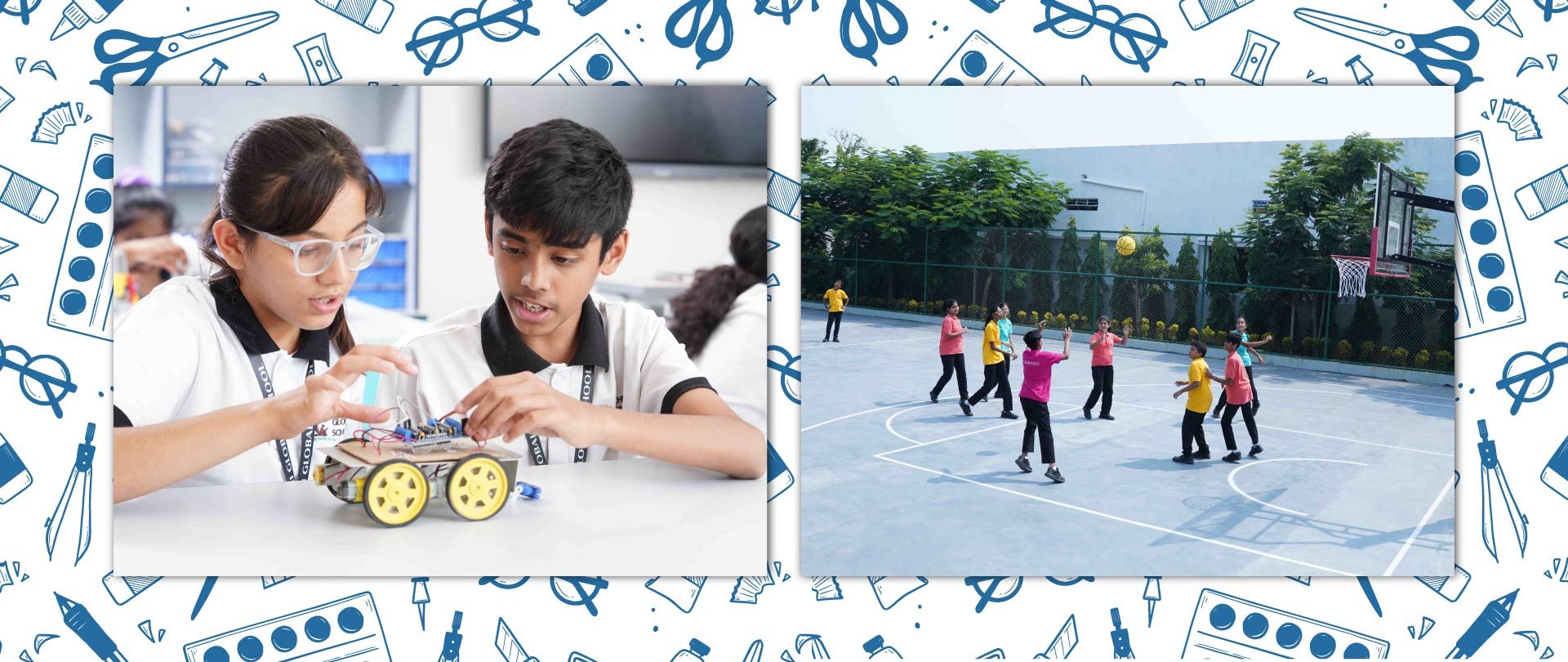Education isn't just about what kids learn in books anymore. While doing well in academics is super important, helping a child grow into a well-rounded person also relies a lot on the importance of co-curricular activities.
Beyond the classroom, kids engage in various activities such as sports, art, clubs, or community service, which bring crucial value to their traditional education.
These cocurricular activities for students give them special chances to find hidden talents, build important life skills, and explore their interests beyond the school syllabus.
This blog will explore how co-curricular activities in school deeply impact kids. We'll show how they help develop critical thinking, teamwork, leadership, and emotional smarts, ultimately creating individuals ready for the world's challenges.
Aachi Global School (AGS) champions the importance of co-curricular activities in school. We nurture well-rounded students, focusing on holistic development for future success.
Introduction of Co-Curricular Activities: What Are Co-Curricular Activities in Child Development?
Cocurricular activities for students are organised experiences that happen right alongside regular school lessons, both inside and outside the classroom. To define co-curricular activities, they're crucial for a child's overall development, going beyond just academic learning or simple fun.
Such co-curricular activities in school include things like sports, music, drama, art clubs, or community service. They offer kids fantastic chances to explore their interests, develop new skills, and learn crucial life competencies that school subjects might not fully cover. This highlights the immense importance of co-curricular activities.
Getting involved helps children build confidence, self-esteem, and resilience as they learn to overcome challenges. Plus, these cocurricular activities for students are often where kids make friends and feel a sense of belonging, which is key for their emotional well-being.
Ultimately, co-curricular engagement significantly contributes to a well-rounded individual, preparing children not just academically but also socially and emotionally for future success.
Suggested Read: The Need and Importance of Physical Education in Schools
What Is the Difference Between Curricular and Co-Curricular Activities?
⇒ Curricular Activities Meaning
These are the core academic programs and subjects forming the official curriculum. They primarily take place within the classroom and focus on delivering foundational knowledge and skills.
⇒ Co-Curricular Activities Meaning
Complementing the formal curriculum, co-curricular activities for students occur to enhance learning by providing practical application of theoretical knowledge and fostering life skills not typically covered in academics.
⇒ Where Do Curricular Activities Occur?
Curricular activities are typically conducted inside the classroom.
⇒ Where Do Co-Curricular Activities Occur?
Co-curricular activities are generally held outside the classroom, sometimes after school hours or on weekends.
⇒ Examples of Curricular Activities
Examples include studying mathematics, science, history, and literature. Their main aim is to build a strong academic base.
⇒ Examples of Co-Curricular Activities
Examples include sports, debates, drama clubs, music, community service, etc. These co-curricular activities in school promote teamwork, leadership, and personal growth.
Suggested Read: What is Holistic Education and Why it’s Important for Every Student?
What Are the Different Types of Co-Curricular Activities in School?
The objectives of co-curricular activities are multifaceted, aiming to provide a well-rounded educational experience beyond the traditional curriculum. Let's get to know some of the best types of co-curricular activities:
A. Sports and Athletics
These activities encompass a wide range of physical pursuits, including team sports like football, basketball, and volleyball, as well as individual sports such as track and field, swimming, and badminton. They promote physical fitness, teamwork, discipline, and healthy competition.
B. Arts and Culture
Co-curricular activities are vital for holistic student development. Engaging in drama, music, dance, debate, or visual arts fosters creativity, self-expression, and critical thinking. The importance of co-curricular activities lies in their ability to enhance cultural awareness, develop teamwork skills, and provide a platform for students to discover and hone their unique talents beyond the academic curriculum.
C. Academic Enrichment Activities
The real definition of co-curricular activities is an educational experience that complements regular coursework, significantly deepening academic understanding and fostering critical thinking. These activities, such as quiz competitions, debate teams, science fairs, essay writing competitions, and mathematics olympiads, encourage research, analytical skills, and intellectual curiosity.
D. Leadership and Community Service
These activities focus on developing students' leadership qualities and fostering a sense of social responsibility. Examples include student councils, prefect bodies, National Service Scheme (NSS) units, and volunteering groups for various social causes like environmental clean-ups, charity drives, or assisting at local shelters. These activities teach students about teamwork, decision-making, empathy, and the importance of contributing to society.
E. Technological and Scientific Innovation
In today's rapidly advancing world, these activities are gaining immense importance. This category includes robotics clubs, coding and programming workshops, science fairs, innovation challenges, and STEM (Science, Technology, Engineering, and Mathematics)-related projects. They encourage logical thinking, problem-solving, and creativity, and they prepare students for future careers in technological fields.
6 Game-Changing Advantages of Co-Curricular Activities for Students
1. Builds Essential Skills
Students build vital skills like critical thinking, teamwork, and leadership through these activities. These are among the key advantages of co-curricular activities, as students gain practical experience, fostering deeper understanding and personal growth beyond academic learning.
2. Boosts Academic Performance
A significant aspect of the benefits of co-curricular activities is their positive influence on academic performance. Through active participation, students cultivate vital skills like discipline, focus, and time management, all of which contribute to enhanced study habits and greater engagement in their learning.
3. Cultivates Self-Esteem and Confidence
Student self-esteem receives a significant boost from achieving personal success or contributing to a team. These accomplishments cultivate a strong sense of capability, fostering a desire for new challenges. It underscores the profound importance of co-curricular activities in a student's holistic growth.
4. Promotes Effective Stress Management
Co-curricular activities play a pivotal role in helping students manage and reduce stress. This highlights the immense importance of co-curricular activities in school. By offering a chance to engage in enjoyable pursuits, they provide a much-needed healthy break from academic pressures, which is essential for maintaining and improving mental well-being.
5. Fosters Social Connections
A key aspect of the objectives of co-curricular activities is fostering social development. These engaging pursuits connect students with diverse peers, building strong social skills, forging lasting friendships, and expanding their networks. They learn to collaborate and communicate effectively, preparing them for future success.
6. Helps to Explore Career Paths
Participation in co-curricular activities is a great way for students to explore potential career paths. These activities, which are school-sponsored experiences complementing the main curriculum, allow students to uncover new interests and build skills directly applicable to various professions.
Suggested Read: Exploring the Importance of Sports in a School Student's Life in 2025
AGS: Empowering Holistic Growth Through Co-Curricular Activities
At Aachi Global School (AGS), we take immense pride in nurturing young minds not just academically, but holistically. Our co-curricular programmes are thoughtfully designed to help students evolve into confident, well-rounded individuals. We firmly believe that learning goes beyond textbooks, and that’s why we offer an impressive spectrum of activities that cater to diverse interests.
The importance of co-curricular activities is evident in our world-class sports infrastructure, which includes a cricket court, a football court, a basketball court, a tennis court, and table tennis facilities, encouraging physical fitness, teamwork, and discipline. For the creatively inclined, our vibrant Art Lab, dynamic Music Lab, and professionally equipped Dance Studio create the perfect environment for artistic expression.
At the heart of innovation, our state-of-the-art AI & Robotics Lab fuels curiosity and inspires students to explore the exciting world of technology. Each of these spaces is more than just a facility—it’s an opportunity for every child to explore their passions, uncover hidden talents, and develop essential life skills.
At AGS, we’re not just building future scholars—we’re shaping future leaders, creators, and innovators. Give your child the AGS advantage! Admissions are now open for the academic year 2025-26. Enrol today!
Looking for more insightful content? Head to our blog section to check our latest posts.
FAQs
1. What Is the CCA Full Form in Education?
CCA stands for Co-Curricular Activities. These are non-academic activities (sports, arts, debates, etc.) that complement classroom learning, fostering holistic development in students.
2. What Do You Mean by Co-Curricular Activities?
Co-curricular activities are non-academic pursuits like sports, arts, and clubs that complement classroom learning, fostering skills like teamwork, leadership, and creativity alongside formal education.
3. What Is the Meaning of Co-Curricular Activities?
Co-curricular activities are school-based activities (like sports, clubs, and arts) that support learning by developing skills beyond academics.
4. What Is the Importance of Co-curricular Activities?
Co-curricular activities enhance social, cognitive, and physical skills, fostering teamwork, creativity, and leadership. They complement academics by improving time management, confidence, and real-world application, ensuring holistic development for students.
5. How Do Co-Curricular Activities for Students Help Them Grow Holistically?
Co-curricular activities foster teamwork, creativity, and leadership while enhancing academic skills. They build confidence, time management, and social abilities, promoting well-rounded growth beyond textbooks. Students develop resilience and real-world skills for holistic success.
6. What Is the Role of the Teacher in Co-curricular Activities?
Teachers play a vital role in co-curricular activities by guiding, motivating, and supervising students; fostering teamwork and creativity; and ensuring activities complement academic learning for holistic development.
7. What Is the Difference Between Curricular and Co-Curricular Activities?
Curricular activities are mandatory academic subjects within the school curriculum (e.g., math, science), while co-curricular activities complement academics and enhance skills (e.g., sports, debates). Both contribute to holistic development but differ in structure and focus.
8. What Are the Main Advantages of Co-Curricular Activities?
The benefits of co-curricular activities are numerous, including enhancing skills like teamwork, leadership, and time management while boosting academic performance. They improve social interaction, build confidence, and provide practical learning, making students well-rounded and prepared for future challenges.
9. What Are the Types of Co-Curricular Activities in School?
Co-curricular activities in schools include sports, arts (music, drama), academic clubs (debate, science), volunteer work, student government, and cultural events. These activities enhance skills, teamwork, and personal growth beyond academics.
10. What Are the Main Objectives of Co-Curricular Activities?
The main objectives of co-curricular activities are to enhance students' skills, foster teamwork, boost creativity, improve physical and mental well-being, and complement academic learning by promoting holistic development and real-world application.




